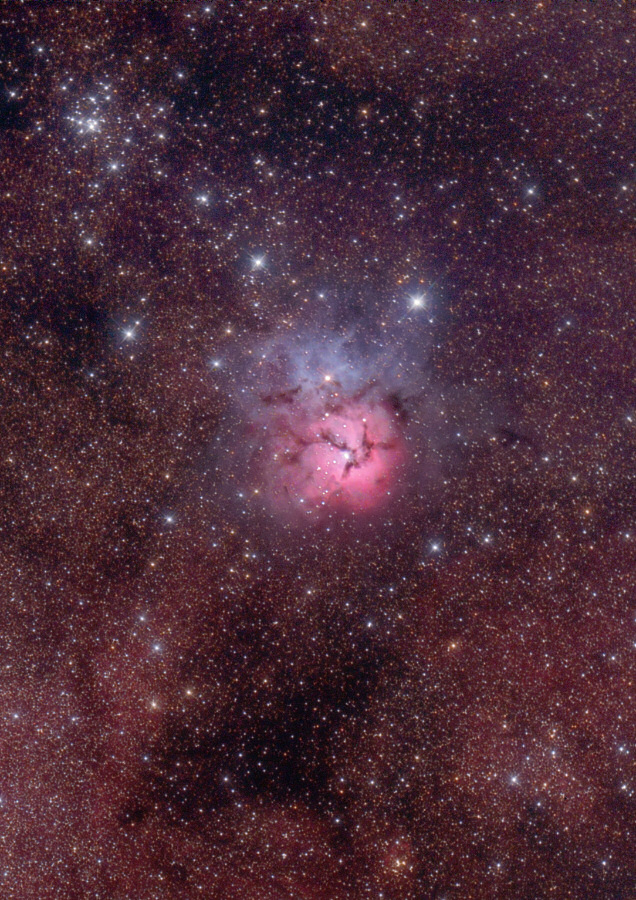
The Trifid Nebula M20 is a rare combination of an emission and reflection nebula. Hot young stars in the southern part of the Trifid have excited the hydrogen atoms in the surrounding gas, causing them to emit red light. In the northern part of the Trifid, in contrast, the stars are not hot enough to excite the gas; the blue glow is the result of starlight being reflected by a myriad of dust particles. Some dust lanes which are not illuminated by starlight run in front of the red parts, forming the famous Trifid lines.
M21, which is a loose star cluster of a few stars, is situated close to the Trifid Nebula and can be found near the upper left corner of this image.
 M8 and M20 - Lagoon and Trifid Nebulae - the full frame of this photograph.
M8 and M20 - Lagoon and Trifid Nebulae - the full frame of this photograph.
Exposure Data
Observing Hints
M20 is easy to find once you have located M8. Just point your telescope a bit to the west and 1.5 degrees due north of M8 until you find two stars surrounded by diffuse nebulosity, you can do that in your finderscope or directly at the eyepiece of your telescope.
The Trifid got its name from the dark lanes which do split the brighter portion of the nebula into three parts in small telescopes and 4-5 parts in bigger scopes or on photographs. These dark lanes are not easy to observe in telescopes smaller than 6" if the nebula is located at low altitude, better views yields an 8" or bigger aperture. In small telescopes you should use moderate magnification to get a glance of them, you will have to experiment there, zoom in until the nebula just begins to dimish. With bigger telescopes magnifications of about 100x will yield the best views of the Trifid lines. With big apertures the individual nebula patches which are separated by the dark lanes do show contrasty edges and look like they were illuminated "from the background", not unlike colored tissue paper in front of a diffuse light source. Use at least 12" of aperture to perceive this effect.
The Trifid Nebula is small and does have relatively high surface brightness, therefore the use of filters is not compulsory; to the contrary, the diffuse reflection nebula which forms the northern part of M20 will simply disappear if you use any nebula filter. But, when the sky brightness there is high, an UHC helps to improve the visibility of the emission part of M20. The reflection part is easier to observe at low magnification. If you use a telescope with at least 8" of aperture, you should be able to see colors in the nebula, the emission nebula appears pink and the reflection nebula slightly blue, just as on photographs. Whether these colors are apparent or not depends not only on telescope size but also on conditions and on the color perception of the observer. Some observers report green and not pink color in the emission part, their eyes respond better to the green OIII line emission. Do not use too much magnification if you want to see the colors of the nebula, as your eye will need maximum light input.
A bit to the northeast of M20 the loose star cluster M21 is located, this object should show up in the same field of view with M20 when using a low-power eyepiece. It is an easy target even for small telescopes.